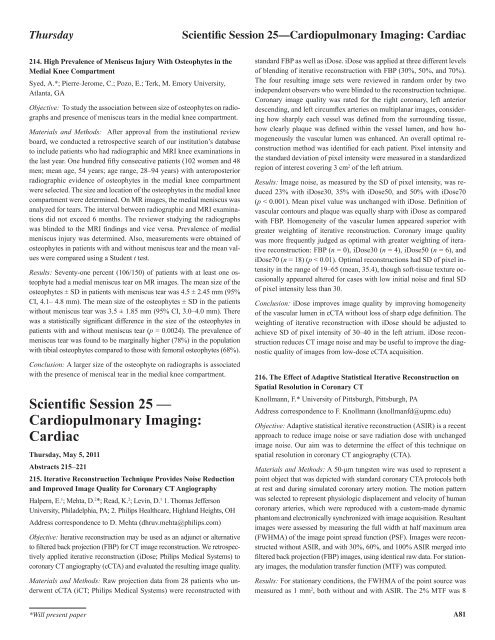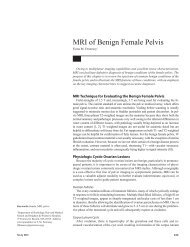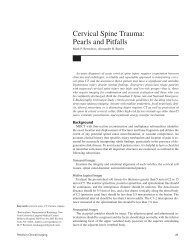Scientific Session 1 â Breast Imaging: Mammography
Scientific Session 1 â Breast Imaging: Mammography
Scientific Session 1 â Breast Imaging: Mammography
You also want an ePaper? Increase the reach of your titles
YUMPU automatically turns print PDFs into web optimized ePapers that Google loves.
Thursday<strong>Scientific</strong> <strong>Session</strong> 25—Cardiopulmonary <strong>Imaging</strong>: Cardiac214. High Prevalence of Meniscus Injury With Osteophytes in theMedial Knee CompartmentSyed, A.*; Pierre-Jerome, C.; Pozo, E.; Terk, M. Emory University,Atlanta, GAObjective: To study the association between size of osteophytes on radiographsand presence of meniscus tears in the medial knee compartment.Materials and Methods: After approval from the institutional reviewboard, we conducted a retrospective search of our institution’s databaseto include patients who had radiographic and MRI knee examinations inthe last year. One hundred fifty consecutive patients (102 women and 48men; mean age, 54 years; age range, 28–94 years) with anteroposteriorradiographic evidence of osteophytes in the medial knee compartmentwere selected. The size and location of the osteophytes in the medial kneecompartment were determined. On MR images, the medial meniscus wasanalyzed for tears. The interval between radiographic and MRI examinationsdid not exceed 6 months. The reviewer studying the radiographswas blinded to the MRI findings and vice versa. Prevalence of medialmeniscus injury was determined. Also, measurements were obtained ofosteophytes in patients with and without meniscus tear and the mean valueswere compared using a Student t test.Results: Seventy-one percent (106/150) of patients with at least one osteophytehad a medial meniscus tear on MR images. The mean size of theosteophytes ± SD in patients with meniscus tear was 4.5 ± 2.45 mm (95%CI, 4.1– 4.8 mm). The mean size of the osteophytes ± SD in the patientswithout meniscus tear was 3.5 ± 1.85 mm (95% CI, 3.0–4.0 mm). Therewas a statistically significant difference in the size of the osteophytes inpatients with and without meniscus tear (p = 0.0024). The prevalence ofmeniscus tear was found to be marginally higher (78%) in the populationwith tibial osteophytes compared to those with femoral osteophytes (68%).Conclusion: A larger size of the osteophyte on radiographs is associatedwith the presence of meniscal tear in the medial knee compartment.<strong>Scientific</strong> <strong>Session</strong> 25 —Cardiopulmonary <strong>Imaging</strong>:CardiacThursday, May 5, 2011Abstracts 215-221215. Iterative Reconstruction Technique Provides Noise Reductionand Improved Image Quality for Coronary CT AngiographyHalpern, E. 1 ; Mehta, D. 2 *; Read, K. 2 ; Levin, D. 1 1. Thomas JeffersonUniversity, Philadelphia, PA; 2. Philips Healthcare, Highland Heights, OHAddress correspondence to D. Mehta (dhruv.mehta@philips.com)Objective: Iterative reconstruction may be used as an adjunct or alternativeto filtered back projection (FBP) for CT image reconstruction. We retrospectivelyapplied iterative reconstruction (iDose; Philips Medical Systems) tocoronary CT angiography (cCTA) and evaluated the resulting image quality.Materials and Methods: Raw projection data from 28 patients who underwentcCTA (iCT; Philips Medical Systems) were reconstructed withstandard FBP as well as iDose. iDose was applied at three different levelsof blending of iterative reconstruction with FBP (30%, 50%, and 70%).The four resulting image sets were reviewed in random order by twoindependent observers who were blinded to the reconstruction technique.Coronary image quality was rated for the right coronary, left anteriordescending, and left circumflex arteries on multiplanar images, consideringhow sharply each vessel was defined from the surrounding tissue,how clearly plaque was defined within the vessel lumen, and how homogeneouslythe vascular lumen was enhanced. An overall optimal reconstructionmethod was identified for each patient. Pixel intensity andthe standard deviation of pixel intensity were measured in a standardizedregion of interest covering 3 cm 2 of the left atrium.Results: Image noise, as measured by the SD of pixel intensity, was reduced23% with iDose30, 35% with iDose50, and 50% with iDose70(p < 0.001). Mean pixel value was unchanged with iDose. Definition ofvascular contours and plaque was equally sharp with iDose as comparedwith FBP. Homogeneity of the vascular lumen appeared superior withgreater weighting of iterative reconstruction. Coronary image qualitywas more frequently judged as optimal with greater weighting of iterativereconstruction: FBP (n = 0), iDose30 (n = 4), iDose50 (n = 6), andiDose70 (n = 18) (p < 0.01). Optimal reconstructions had SD of pixel intensityin the range of 19–65 (mean, 35.4), though soft-tissue texture occasionallyappeared altered for cases with low initial noise and final SDof pixel intensity less than 30.Conclusion: iDose improves image quality by improving homogeneityof the vascular lumen in cCTA without loss of sharp edge definition. Theweighting of iterative reconstruction with iDose should be adjusted toachieve SD of pixel intensity of 30–40 in the left atrium. iDose reconstructionreduces CT image noise and may be useful to improve the diagnosticquality of images from low-dose cCTA acquisition.216. The Effect of Adaptive Statistical Iterative Reconstruction onSpatial Resolution in Coronary CTKnollmann, F.* University of Pittsburgh, Pittsburgh, PAAddress correspondence to F. Knollmann (knollmanfd@upmc.edu)Objective: Adaptive statistical iterative reconstruction (ASIR) is a recentapproach to reduce image noise or save radiation dose with unchangedimage noise. Our aim was to determine the effect of this technique onspatial resolution in coronary CT angiography (CTA).Materials and Methods: A 50-μm tungsten wire was used to represent apoint object that was depicted with standard coronary CTA protocols bothat rest and during simulated coronary artery motion. The motion patternwas selected to represent physiologic displacement and velocity of humancoronary arteries, which were reproduced with a custom-made dynamicphantom and electronically synchronized with image acquisition. Resultantimages were assessed by measuring the full width at half maximum area(FWHMA) of the image point spread function (PSF). Images were reconstructedwithout ASIR, and with 30%, 60%, and 100% ASIR merged intofiltered back projection (FBP) images, using identical raw data. For stationaryimages, the modulation transfer function (MTF) was computed.Results: For stationary conditions, the FWHMA of the point source wasmeasured as 1 mm 2 , both without and with ASIR. The 2% MTF was 8*Will present paperA81
















